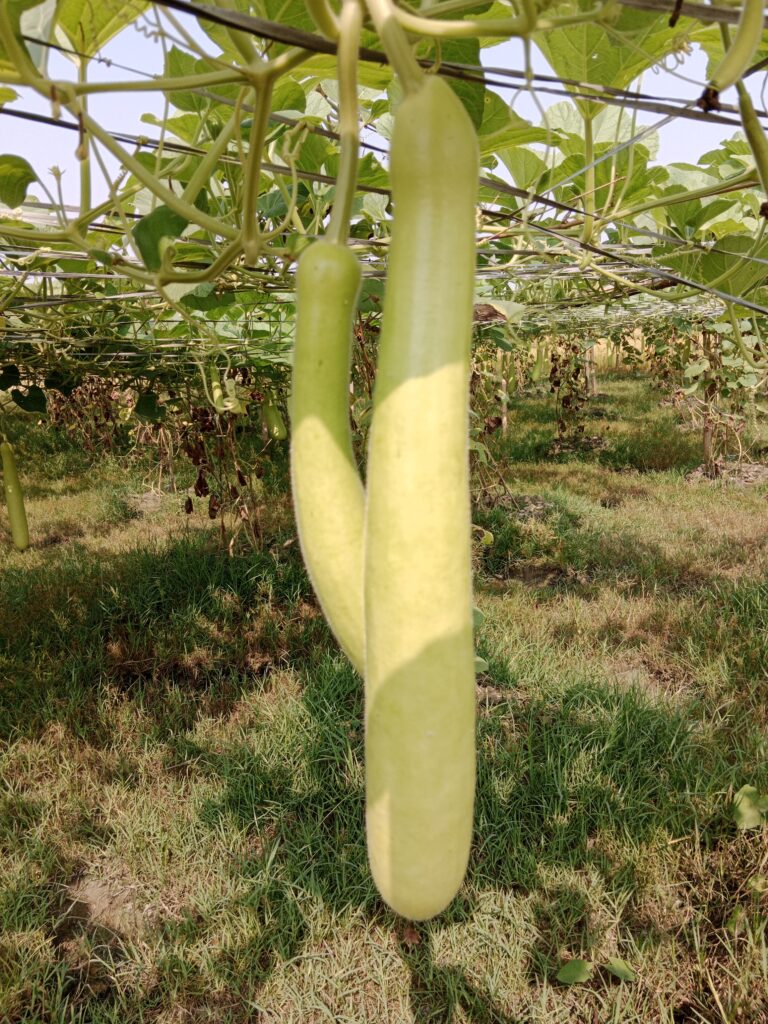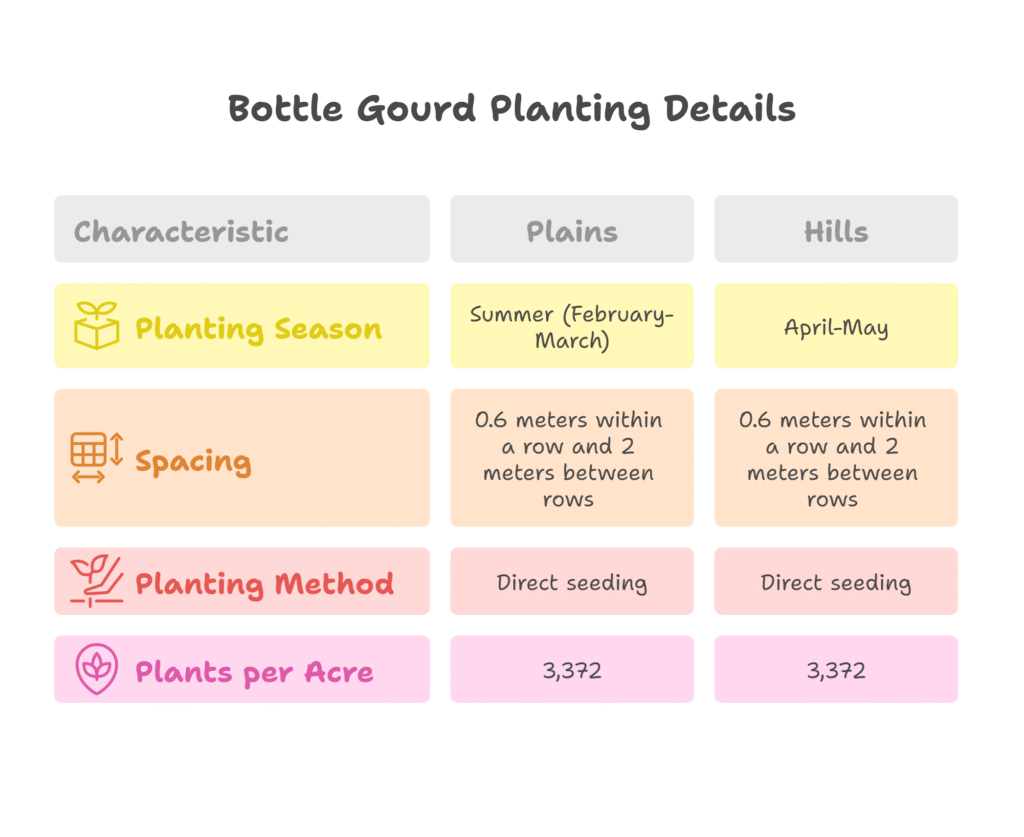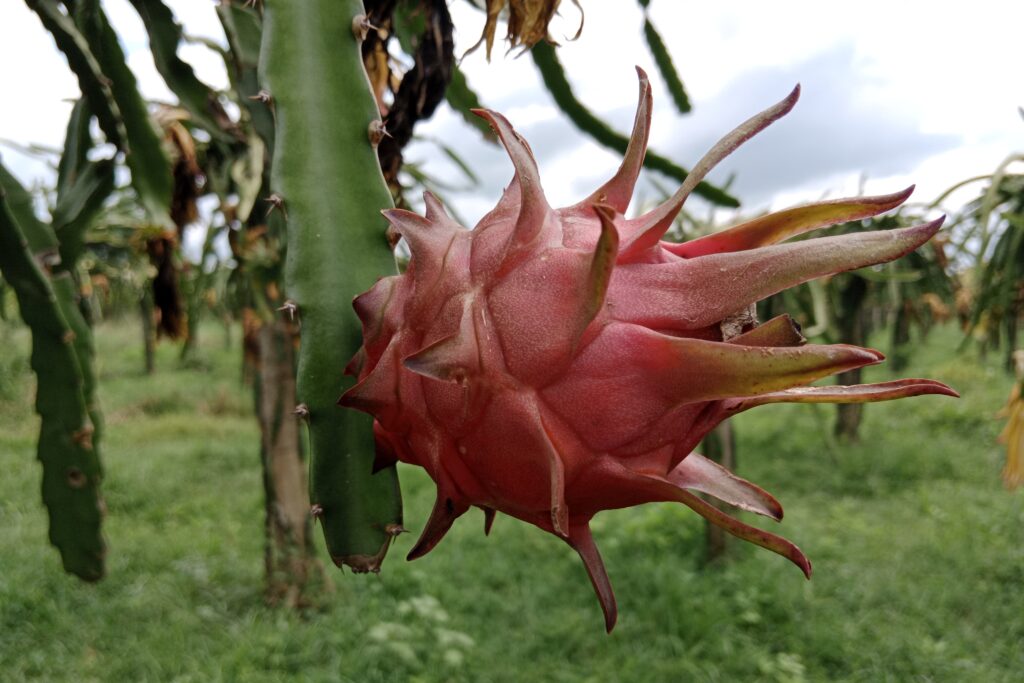Bottle Gourd Farming
Bottle gourd farming profit per acre demonstrates strong economic potential, making it a lucrative option for farmers. With a total investment of NRs. 41,000 and a gross income of NRs. 135,000 (based on a yield of 9,000 kg sold at NRs. 15 per kg), the net profit amounts to NRs. 94,000 per acre. This translates to a profit margin of approximately 69.63% and a remarkable return on investment (ROI) of around 229.27%. Such profitability highlights the importance of efficient resource management and optimized cultivation practices in maximizing returns from bottle gourd farming.

Land Preparation
Begin 3-4 weeks before planting with deep plowing (20-25 cm) using a moldboard plow or tractor to expose pests and bury weeds. Follow immediately with harrowing or rotavating to break clods and level the field, ensuring even water distribution and preventing waterlogging. Allow the soil to weather in the sun for 1-2 weeks to kill pathogens and weed seeds.
Then perform 2-3 cross plowings or harrowings to create a fine, crumbly tilth. Form 15-20 cm high raised beds or ridges and furrows for essential drainage. Finally, incorporate 10-15 tons/acre of well-decomposed FYM or compost during the last harrowing.
Soil Type
Fertile, well-drained sandy loam or loamy soil with a pH range of 6.0 to 7.0—from slightly acidic to neutral—is the best soil for agriculture. The crop can withstand a wider pH range of 5.0 to 7.5, but productivity may suffer if it is outside of this ideal range. Very sandy soils with little water and nutrient retention and heavy clay soils with poor drainage and waterlogging are to be avoided.
Climatic Requirements
| Parameter | Details |
| Temperature | · Optimal Growth: 25°C – 35°C · Germination: Requires warm soil, minimum 18°C – 20°C · Sensitivity: Highly sensitive to frost; growth is severely affected below 15°C and above 40°C. |
| Sunlight | · Requires full sunlight (6–8 hours daily) for optimal growth, flowering, and fruiting |
| Rainfall | · Thrives in moderate rainfall (600–1500 mm annually); requires irrigation during dry spells; heavy, continuous rain during flowering/fruiting increases disease risk |
| Humidity | · Moderate humidity is ideal; very high humidity combined with high temperatures increases fungal disease pressure |
Major Cultivars
The selection of major cultivars should be based on several criteria, including the climate in the area, consumer preferences for fruit color, size, and form, disease resistance, and prospective yield.
| Type | Varieties/Notes |
| Long Cylindrical | Pusa Summer Prolific Long, Pusa Naveen, Arka Bahar, CO-1, Konkan Harita (Green), Punjab Long, Pusa Hybrid 3 |
| Oblong/Oval | Pusa Summer Prolific Round, Pusa Meghdoot, Punjab Round, PKM 1 |
| Bottle Shaped | Less common commercially, but grown |
| High-Yielding Hybrids | Many F1 hybrids available (e.g., MH 10, MH 15, NS 816, Nun 3015). Offer uniformity, vigor, and often disease resistance. |
| Disease Resistant | Some varieties show tolerance to powdery mildew or viruses |
Seed Rate
A seed rate of 2 kg is sufficient for one acre of land, and the seeds should be treated with Bavistin at 0.2% (3 g per kg of seed) to protect against soil-borne fungal infections.
Planting
a) Planting Season
This crop is primarily warm-season, with the main planting period in the Plains occurring during summer (February-March), while in the Hills, planting typically takes place in April-May.

b) Spacing
It is advised to leave 0.6 meters between plants within a row and 2 meters between rows. To allow for vine expansion, provide sufficient light penetration, and encourage healthy air circulation, proper spacing is crucial.
c) Planting Method
Direct seeding is the most popular planting technique. Two to three seeds are planted in each pit at a depth of two to three centimeters, and the strongest one or two seedlings are kept when true leaves emerge. Three to four weeks before field planting, seeds are sown in nursery beds or pro-trays for early crops or under controlled conditions. Healthy seedlings with three to four true leaves are then carefully transplanted to prevent root disturbance and immediately watered.
d) Number of Plants per Acre:
Based on the above spacing, approximately 3,372 plants can be accommodated per acre.
Intercropping
Intercropping with bottle gourd is suitable during the initial 6–8 weeks before the vines spread and cover the ground, allowing short-duration crops like radish, carrot, onion, garlic, leafy greens (such as spinach and amaranth), bush beans, and marigold (used as a trap crop or pest repellent) to be grown alongside.
This practice enhances land use efficiency, provides additional income, suppresses weeds, and can improve soil fertility, especially with legumes. However, care should be taken to avoid tall or nutrient-demanding crops that may compete with bottle gourd for light, water, or nutrients, and sufficient spacing for the main crop must be maintained.
Irrigation
The critical stages for irrigation and care are germination, flowering, fruit setting, and fruit development. Furrow irrigation is the most common method used, while drip irrigation is highly efficient as it conserves water, reduces disease by keeping foliage dry, and enables fertigation, which is the application of fertilizer through irrigation.
| Growth Stage | Irrigation Frequency & Details | Critical Notes |
| Initial Stage | Light, frequent irrigations (every 3-4 days in summer) to establish plants. | Essential for root development. |
| (1st month) | ||
| Vegetative & Flowering | Regular irrigation every 5-7 days. Frequency depends on soil type and prevailing weather. | Adjust based on soil moisture and climate. |
| Fruit Development | Maintain consistent soil moisture. Irrigate every 4-5 days in hot weather. | Water stress leads to misshapen, bitter gourds. |
Fertilizer and Manure
| Fertilizer and Manure | Application Details | ||
| Basal Dose (at planting) | Apply in pits: 10–15 tons FYM/compost + 50 g SSP + 50 g MOP (Muriate of Potash) per pit | ||
| Top Dressing | · 1st Dose (Vine Spread, ~3-4 weeks): 50 g Urea per pit (or equivalent nitrogen) | ||
| · 2nd Dose (Start of Flowering, ~6-7 weeks): 50 g Urea + 50 g MOP per pit | |||
| · 3rd Dose (Fruit Setting Stage): 50 g Urea per pit (optional, based on plant vigor) | |||
| Flowering Stage | Spray phosphorus-rich fertilizer (NPK 0:52:34) and boron (0.1–0.25%) | ||
| Fruit Setting Stage | Spray potassium-rich fertilizer (NPK 0:0:50) and zinc (ZnSO4 0.5%) | ||
Weed Control
Weed management is especially important during the initial 4 to 6 weeks after planting, before the vines have expanded enough to shade the soil. During this period, 2 to 3 shallow hoeings can effectively control weed growth, but care should be taken to avoid root injury from deep hoeing.
Applying mulch—either organic (like straw or dried leaves) or plastic—after the first weeding helps retain soil moisture, reduce weed emergence, and regulate soil temperature. Chemical weed control may also be used by applying pre-emergence herbicides such as Pendimethalin (500 g to 1 kg a.i. per acre) or Fluchloralin (0.75 kg a.i. per acre) right after sowing or before transplanting, followed by light irrigation.
However, herbicide use should be done cautiously and in strict adherence to label instructions, as post-emergence herbicide choices for cucurbit crops are limited.
Flowering and Fruit Management

| Aspect | Details | ||
| Flowering | · Monoecious plants with separate male and female flowers; male flowers appear earlier and in greater numbers; female flowers have a small ovary (gourd) at the base. | ||
| Pollination | · Primarily carried out by bees and other insects; poor pollination often leads to low fruit set. | ||
| Pollination Interventions | · Hand Pollination: Recommended for higher yields, especially during early/late season or in protected cultivation. Collect male flowers (8–10 AM), remove petals, and gently rub anthers onto the stigma of open female flowers. · Beehives: Installing beehives in or near the field significantly enhances natural pollination. | ||
| Fruit Setting & Development | · Ensure consistent irrigation and sufficient potassium nutrition; avoid water stress during this critical stage. | ||
Pest and Disease Management
Common Pests
a). Fruit Fly (Bactrocera spp.)
Fruit fly (Bactrocera spp.) is the most devastating pest, with females laying eggs under the fruit skin and larvae tunneling inside. Effective control measures include bait sprays (Malathion with protein hydrolysate), pheromone traps, field sanitation by removing infested fruits, neem oil sprays, prompt harvesting, and bagging of young fruits.
b) Red Pumpkin Beetle
The red pumpkin beetle poses a serious threat as adults feed on seedlings and cotyledons, while grubs damage roots and stems. Effective control includes seed treatment with Imidacloprid, foliar sprays using Malathion or Carbaryl, and the application of neem cake to the soil.
c) Aphids & Whiteflies
Aphids and whiteflies are sap-sucking pests that also transmit viruses, leading to reduced plant vigor and yield. Control measures include the use of yellow sticky traps, neem oil, insecticidal soap, and insecticides like Spiromesifen and Imidacloprid.
d) Leaf Miner
Leaf miners cause damage by tunneling through leaves during their larval stage. Control methods include removing and destroying mined leaves, along with spraying Spinosad or Abamectin for effective management.
Common Diseases
a). Powdery Mildew
Powdery mildew appears as white powdery patches on leaves and stems. It can be managed by growing resistant varieties, applying sulfur dust or sprays, using fungicides like Dinocap, Hexaconazole (2ml /liter), or wettable sulfur, and ensuring proper plant spacing to improve air circulation.
b) Downy Mildew
This disease appears as yellow angular spots on the upper leaf surface with purplish downy growth underneath, thriving in cool, humid nights. Control measures include fungicides, Metalaxyl + Mancozeb or Copper oxychloride, and avoiding overhead irrigation.
c) Anthracnose
Anthracnose causes sunken brown or black spots on leaves, stems, and fruits. Effective control includes seed treatment with Carbendazim and regular sprays of Mancozeb or Carbendazim at 2ml / liter to manage the disease.
d) Damping Off
Damping-off affects seedlings, causing them to collapse at the soil line. It can be controlled by avoiding waterlogging, ensuring well-drained soil, treating seeds with Thiram or Captan, and drenching the soil with Copper Oxychloride or Bordeaux mixture.
e) Virus Diseases
Viral diseases cause mosaic patterns, stunted growth, and distorted leaves in plants. Effective management includes controlling insect vectors like aphids and whiteflies, removing and destroying infected plants, and cultivating resistant varieties.
Harvesting
| Harvesting Aspect | Details |
| Stage | Harvest fruits when tender, immature, with soft seeds; skin should be green and shiny, flesh white and firm; avoid over-mature fruits that become fibrous, hard, and bitter. |
| Timing | First harvest generally occurs 60-75 days after planting; harvesting continues for 6-8 weeks with multiple pickings every 3-4 days. |
| Maturity Indicators | – Fruit reaches marketable size (varies by cultivar) – Shiny green skin (dullness indicates maturity) – Faint white bloom may appear on skin – Thumbnail test: skin easily pierced with thumbnail |
| Method | Use a sharp knife or secateurs to cut the fruit stalk, leaving 2-3 cm attached to the fruit; handle fruits carefully to avoid bruising. |
Yield
The typical yield of this crop ranges between 8,000 and 15,000 kilograms per acre, equivalent to 8 to 15 metric tons per acre.
Cost of Investment per Acre for Bottle Gourd
| S.N. | Category | Cost (NRs.) |
| 1 | Land Preparation (plowing) | 10,000 |
| 2 | Seed | 2,000 |
| 3 | Seed Planting | 2,000 |
| 4 | Trellis | 4,000 |
| 5 | Fertilizers and Manure | 6,000 |
| 6 | Irrigation | 5,000 |
| 7 | Weed Control (pre & post-emergence) | 1,000 |
| 8 | Pest & Disease Control | 3,000 |
| 9 | Harvesting | 5,000 |
| 10 | Miscellaneous Costs | 3,000 |
| Total Cost | 41,000 |
Income from per Acre Bottle Gourd Farming
| Particulars | Value | ||
| Estimated Yield | 9,000 kg | ||
| Market Price | NRs. 15 per kg | ||
| Total Income | NRs. 135,000 | ||
Analysis of Bottle Gourd Farming Profit Per Acre
| Parameter | Amount (NRs.) |
| Total Income | 135,000 |
| Total Investment Cost | 41,000 |
| Net Profit | 94,000 |
| Return on Investment (ROI) | 229% (Profit is 2.29 times the investment) |
Crop Calendar of Bottle Gourd
*(Duration: ~20-22 weeks from land prep to final harvest)*
| Phase | Timeline | Key Activities & Management Practices |
| 1. Land Preparation | Plains: Early Jan Hills: Early Mar | • Deep plowing (20-25 cm) + harrowing • Sun-drying soil for 1-2 weeks • 2-3 cross-plowings for fine tilth • Form raised beds/ridges • Incorporate 10-15 tons/acre FYM/compost |
| 2. Seed Sowing | Plains: Feb-Mar Hills: Apr-May | • Direct seeding: 2-3 seeds/pit (2-3 cm depth) • Nursery: Start 3-4 weeks earlier for transplants • Seed treatment: Bavistin 0.2% (3g/kg seed) |
| 3. Early Growth (0-4 Weeks) | Post-planting | • Thinning: Retain 1-2 seedlings/pit after true leaves emerge • Irrigation: Light & frequent (every 3-4 days) • Weed Control: 2-3 shallow hoeings; apply mulch • Intercropping: Plant radish/carrot/onion/bush beans |
| 4. Vegetative Stage (4-6 Weeks) | • 1st Top Dressing: 50g Urea/pit • Pest Control: Monitor for Red Pumpkin Beetle (spray Malathion if needed) • Training: Begin trellising vines (if using) | |
| 5. Flowering (6-8 Weeks) | • 2nd Top Dressing: 50g Urea + 50g MOP/pit • Foliar Spray: Phosphorus (NPK 0:52:34) + Boron 0.1-0.25% • Pollination: Hand pollination (8-10 AM) or install beehives • Irrigation: Every 5-7 days | |
| 6. Fruit Development (8-12 Weeks) | • 3rd Top Dressing (Optional): 50g Urea/pit (if plants vigorous) • Foliar Spray: Potassium (NPK 0:0:50) + ZnSO₄ 0.5% • Pest/Disease Control: Fruit fly traps/baiting; monitor for Downy/Powdery Mildew • Irrigation: Maintain soil moisture (every 4-5 days in heat) | |
| 7. Harvesting | Start: 60-75 DAP Duration: 6-8 weeks | • Frequency: Pick every 3-4 days • Indicators: Shiny green skin, soft seeds, passes thumbnail test • Method: Cut stalk with 2-3 cm attached using secateurs • Avoid: Bruising; over-mature fruits (fibrous/bitter) |
| 8. Post-Harvest | After final pick | • Field sanitation: Remove crop debris • Soil analysis for next season |
Source
Indian Council of Agricultural Research (ICAR)
Food and Agriculture Organization (FAO)
American Phytopathological Society (APS)
Nepal Agricultural Research Council (NARC)



Pingback: Snake Gourd Farming Profit Per Acre -